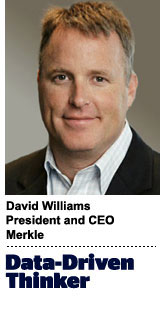 “Data-Driven Thinking” is written by members of the media community and contains fresh ideas on the digital revolution in media.
“Data-Driven Thinking” is written by members of the media community and contains fresh ideas on the digital revolution in media.
Today’s column is written by David Williams, president and CEO at Merkle.
Across industries, today’s marketing conversation is all about the personalized experience. Everything you hear and read seems to be focused on the importance of delivering one-to-one messaging across digital media.
But when it comes to truly embracing an enterprise approach to people-based marketing, I don’t think those of us in the marketing and advertising profession have quite wrapped our collective minds around what customer strategy really means.
While one-to-one marketing is the ideal utopian state, in the real world most people simply don’t know how to market to individuals. That’s because we never really had to do it before – not at scale. Traditionally, once marketers’ scale crossed that threshold where they could no longer market to a known person, they began marketing to a handful of personas. They did targeting based on segments, and even though they may have called it one-to-one marketing, they never really had the ability to target, personalize or measure on a truly individual basis across large audiences.
The scale and sophistication of those types of skills are completely different in our fully addressable world. So let’s say a brand has an addressable target market of 50 million US households. In this scenario, there would literally be 50 million distinct contact management plans. The brand would have to actively create and manage 50 million customer relationships. That includes making individual targeting decisions on a daily basis, informing those decisions with individual insights and creating personalized experiences for each individual.
Nobody has ever done it at that level of scale – even in this day and age, when the technological capabilities exist to do it. The reason: We don’t have a complete understanding of what customer strategy is. Is it segmentation? Is it journey mapping? Is it funnel management?
I was recently in a meeting with the senior executives of a very large retailer who were talking about their customer strategy. On a whim, I asked if they could share it with me. They seemed surprised that I wanted to see an actual, tangible, written strategy. It turned out they really didn’t have one – and they didn’t know what it would look like if they did.
At its fundamental core, customer strategy all comes down to lifetime value. If marketers are not using lifetime value as their primary economic metric, they can’t do people-based marketing. Without it, they’re just optimizing to a campaign, which is no better than marketing to a persona. People experience life stage changes, economic status changes and behavior changes, but if marketers only optimize campaign by campaign, they miss these fluctuations. Lifetime value is the only common thread that links campaigns and can be optimized over time for a one-to-one approach.
We talk a lot about the use of data, analytics, technology, personalization and targeting, but in reality, building lookalike models on individual social platforms is child’s play compared to the level of sophistication that’s possible. Today’s textbook customer database contains a complete history on every targeted prospect and customer in a marketer’s universe. It tracks the changing wants, needs, desires, behaviors of each customer and potential customer. It’s the perfect conduit for a customer strategy that optimizes to their value over the long haul, not to their behavior in a given campaign.
So if the tools are there, why is this not happening faster? In principle, this is about direct marketing. These are the disciplines that have been used for many decades, adjusting over time for technological advancements. The term “direct marketing” has earned the status of old-school but its fundamental principles still hold true, and unless you truly understand them and can apply them to the digital world at scale, you’ll never capitalize on today’s addressable opportunity.
Simply put, the knowledge level has to catch up with the technology. Doing this takes resources, know-how and a different set of governance policies. It’s a whole different way of thinking from brand-level or even persona-level marketing. It is a really complex and sophisticated process that, for the most part, the industry still doesn’t understand.
People understand brand marketing – one-to-many. Marketers decide how they want their brand to look and feel, and they distribute that messaging to personas. They have to have a brand strategy, but marketing to consumer profiles is really brand strategy linked to campaign and product strategies. It’s not one-to-one.
The ability to market to a known individual trumps brand. Brands are marketing to millions of individuals, about whom they have a tremendous amount of information. But how should they coordinate which of those people they want to talk to at a given moment? Through what media? With what offer sets? And in what sequence and creative? Whatever the scenario, this is what is meant by true one-to-one marketing at scale.
To be clear, I’m not talking about doing good programmatic or SEO. I’m talking about doing good contact strategy, at the enterprise level, over an extended period of months and years, linked to an actual, known consumer. Not just on Facebook or Google, but at every touch point. And the only valuable metric is the lifetime value of that consumer.
In this age of addressability, we all better make it our mission to figure out what real customer strategy is and get busy building the ability to operationalize it. Thanks to leaders like Adobe and Oracle, the technology has leapt ahead of our ability to capitalize on it. Competitive advantage will smile on those who find a way to fully engage the technology to enable customer strategy that maximizes lifetime value.
Follow David Williams (@merkle_david), Merkle (@merkleCRM) and AdExchanger (@adexchanger) on Twitter.












